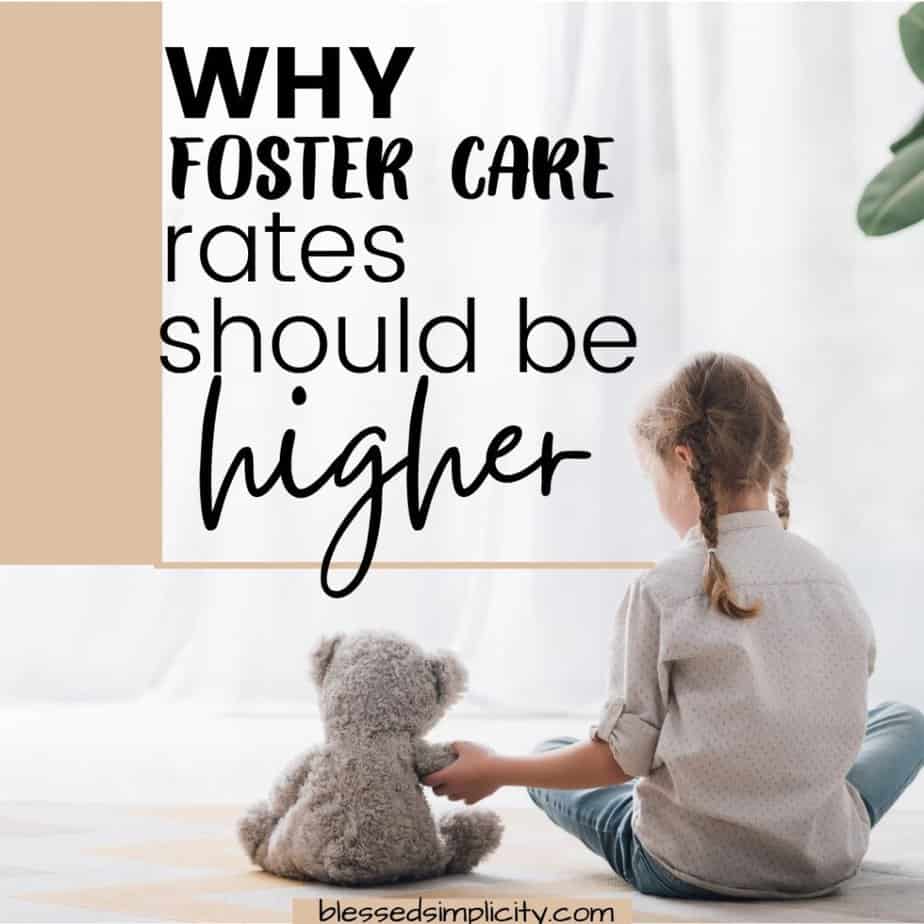Why foster care rates should be higher
There’s a lot of discussion about why foster care rates should be higher. If you are considering becoming a foster parent you should know foster care reimbursement rates are not enough to cover more than the basic needs for a child. Among other tips for foster parents, it is important to be frugal with your reimbursement money.

*This post contains affiliate links. Please see full disclosure policy below.
Foster care is one of the most rewarding jobs around, but sadly, the rates for reimbursement and cost of fostering aren’t always fair. We think that foster parents should be paid more for all they do to help children in need. Join the conversation and tell your state legislators why you think they should increase reimbursements and costs for foster families!
Why Foster Care Rates Should Be Higher
When you become a foster parent, you open your heart and your home to a child in need. It’s a selfless act of compassion and love. But it’s also a lot of work.
From the mountains of paperwork to the emotional rollercoaster of meeting new kids and saying goodbye to old ones, foster parenting is not for the faint of heart.
So why do we as a society continue to undervalue the important role that foster parents play? Nowhere is this more evident than in the area of reimbursement rates.
Foster kids need more than basic needs
Foster children need more than just basic needs to thrive in their foster homes. In addition to food, shelter, and clothing, foster children require emotional support and guidance from foster parents in order to develop healthy relationships and communication skills.
They also need access to educational resources such as tutoring or special classes which can help them catch up with their peers. Moreover, foster kids should have the opportunity for recreational activities like sports or art lessons so that they can learn how to express themselves in a positive way.
With these extra supports, foster families can provide an environment where foster kids feel safe and secure while learning important life skills.
Impact of current foster care reimbursement rates
Foster care is an invaluable service that provides foster parents with the opportunity to provide a safe and loving home for foster children. However, foster parents often receive low reimbursements—sometimes only around 70% of their cost—which makes it difficult to sustain foster care services at their current rate.
This means foster families are not receiving sufficient financial support to cover costs associated with providing quality foster care, leading to negative impacts on both foster children and foster parents.
Who determines foster care reimbursement rates?
Foster care reimbursement rates are determined by each individual state, with the majority of states falling below the actual cost of care. In fact, according to a recent study by The Stanford Institutional Review Board, only 4 states reimburse foster parents at rates that cover the actual cost of care. That means that in 46 states, foster parents are essentially subsidizing the care of children in their own homes!
Why are foster care reimbursement rates so low?
There are a number of reasons why this is occurring, but one key factor is that our country has not been prioritizing investment in children’s programs over the last few decades.
In fact, child welfare spending as a percentage of total federal spending is at its lowest point since 1974! This lack of investment has led to an overall decline in reimbursement rates, which only further exacerbates the problem.
Possible Solutions to increase foster care rates
One possible way to increase foster care rates is through tax credits. Tax credits are a form of government financial aid that can help foster families cover some of the costs associated with providing foster care. For example, foster parents may be able to receive tax credits for medical expenses related to their foster children or educational expenses such as tuition and books.
Additionally, state governments can provide increased funding for foster care services in order to better support foster families and ensure they have access to all the resources needed to provide quality care for their foster children. This could include additional reimbursements for housing costs or specialized training programs designed specifically for foster parents.
With these extra supports, foster families will be better equipped with the tools necessary to give their foster children a safe and secure home environment.

When you become a foster parent, you open your heart and your home to a child in need. It’s a selfless act of compassion and love. But it’s also a lot of work. From the mountains of paperwork to the emotional rollercoaster of meeting new kids and saying goodbye to old ones, foster parenting is not for the faint of heart. So why do we as a society continue to undervalue the important role that foster parents play? Nowhere is this more evident than in the area of reimbursement rates.
More foster care posts
- Foster Bedroom Requirements
- How to Help a Foster Child Prepare for a Visit
- Fostering Medically Fragile Infants
- What is Medically Fragile Foster Care?




